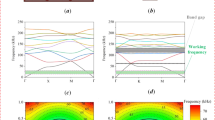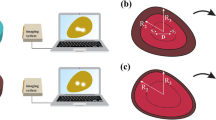Abstract
A layout optimization method for a two-dimensional acoustic lens system used in underwater imaging is presented. To this end, a shape and topology optimization is formulated for the design problem of a lens system for the first time. The layout of a lens system to be optimized includes the number of lenses, shape of lens surfaces, distances between lenses, and lens materials. A phase field function is employed to implicitly parameterize the boundaries of the lenses, which move according to design sensitivities during optimization. Multiple lenses with different materials are optimized using a single phase field function. Because the ratio of the acoustic wavelength with respect to lens dimensions is large, diffraction effects should be taken into account. Accordingly, the performance of a lens system should be analyzed using wave acoustics and not the ray tracing method. The optimization problem is formulated to remove the aberrations of coma and field curvature. The validity of the proposed optimization method is demonstrated by solving benchmark design problems including a lens system with a large field of view.
















Similar content being viewed by others
Notes
A lens system refers to an assembly of lens units. In literatures for the optical lens design, the name “element” is often used to denote a single lens. Thus a lens system consists of one or more lenses or elements. In this investigation, mirrors and prisms are not taken into account for the design of a lens system.
References
Andkjær JA, Sigmund O, Breinbjerg O (2012) Wave manipulation by topology optimization. Ph.D. thesis, DTU Mechanical Engineering
Belcher EO, Dinh HQ, Lynn DC, Laughlin TJ (1999) Beamforming and imaging with acoustic lenses in small, high-frequency sonars. Proceedings of Oceans '99 MTS/IEEE, vol 3. Seattle, WA, 1495–1499 September 13–16, 1999
Belcher EO, Hanot W, Burch J (2002) Dual-frequency identification sonar (DIDSON). Proceedings of the 2002 International Symposium on Underwater Technology, 187–192
Blank L, Farshbaf-Shaker MH, Garcke H, Rupprecht C, Styles V (2014) Multi-material phase field approach to structural topology optimization. Int Ser Numer Math 165:231–246
Borrvall T (2001) Topology optimization of elastic continua using restriction. Arch Comput Meth Eng 8:351–385
Comsol (2013) Comsol Acoustics Module User’s Guide, Version 4.3b
Dühring MB, Jensen JS, Sigmund O (2008) Acoustic design by topology optimization. J Sound Vib 317:557–575
Enquist B, Majda A (1979) Radiation boundary conditions for acoustic and elastic wave calculations. Communications in Pure Applied Mathematics 32:313–357
Fischer RE, Tadic-Galeb B, Yoder PR (2008) Optical system design, 2nd edn. McGraw-Hill Education, New York
Fletcher R (1981) Nonlinear programming. In: Practical methods of optimization, vol 2. Wiley, Chichester, pp 120–156
Gain AL, Paulino GH (2012) Phase-field topology optimization with polygonal elements: a finite volume approach for the evolution equation. Struct Multidiscip Optim 46(3):327–342
Geary JM (2002) Introduction to lens design with practical Zemax examples. Willmann-Bell, Inc., Richmond
Haber RB, Bendsøe MP, Jog CS (1996) A new approach to variable topology shape design using constraint on the perimeter. Structural Optimization 11:1–12
Hecht E (2003) Optics. Addison-Wesley Publishing Company, 4th edn.
Isakari H, Kuriyama K, Harada S, Yamada T, Takahashi T, Matsumoto T (2014) A topology optimisation for three-dimensional acoustics with the level set method and the fast multipole boundary element. Mechanical Engineering Journal 1(4):14–00121
Jensen JS, Sigmund O (2005) Systematic design of acoustic devices by topology optimization. In Twelfth international congress on sound and vibration, ICVS12 2005, Lisbon
Kamgar-Parsi B, Johnson B, Folds DL, Belcher EO (1997) High-resolution underwater acoustic imaging with lens-based systems. Int J Imaging Syst Technol 8:377–385
Matsuki T, Yamada T, Izui K, Nishiwaki S (2014) Topology optimization for locally resonant sonic materials. Appl Phys Lett 104:191905
Mori K, Ogasawara H, Nakamura T, Tsuchiya T, Endoh N (2011) Design and convergence performance analysis of aspherical acoustic lens applied to ambient noise imaging in actual ocean experiment. Jpn J Appl Phys 50:07HG09
Nakamura T, Hashimoto M, Mori K, Kamakura T, Anada T (2005) Sound fields focused by a biconcave acoustic lens for normal and oblique incidence. Proceedings of Oceans 2005– Europe 1. Brest, France, 62–67 June 20–23
Noguchi Y, Yamada T, Otomori M, Izui K, Nishiwaki S (2015) An acoustic metasurface design for wave motion conversion of longitudinal waves to transverse waves using topology optimization. Appl Phys Lett 107:221909
Sato Y, Miyazaki A, Miyazaki Y, Mori Y, Nakamura T (2007) Design of an absolutely aplanatic acoustic lens. Jpn J Appl Phys 46(7B):4982–4989
Takase Y, Anada T, Tsuchiya T, Endoh N, Nakamura N, Tukioka T (2005) Real-time sonar system using acoustic lens and numerical analysis based on 2D/3D parabolic equation method. Proceedings of Oceans 2005– Europe 1. Brest, France, 23–28 June 20–23
Takezawa A, Nishiwaki S, Kitamura M (2010) Shape and topology optimization based on the phase field method and sensitivity analysis. J Comput Phys 229(7):2697–2718
The Mathworks (2015) Matlab–User’s Guide. The Mathworks Inc., USA
Tran QD, Jang GW, Kwon HS, Cho WH, Cho SH, Cho YH, Seo HS (2016) Shape optimization of acoustic lenses for underwater imaging. J Mech Sci Technol 30:4633–4644
Tsukioka S, Aoki T, Ochi H, Shimura T, Sawa T, Nakamura T, Anada T, Kaihou I, Noda H (2002) Development of an acoustic lens for an imaging sonar for autonomous underwater vehicle “Urashima” and experimentation in a water tank. Jpn J Appl Phys 41:3970–3973
Wallin M, Ristinmaa M, Askfelt H (2012) Optimal topologies derived from a phase-field method. Struct Multidiscip Optim 45(2):171–183
Zemax (2011) Optical Design Program User’s Manual, Radiant Zemax LLC
Zhang WS, Zhong WL, Guo X (2015) Explicit layout control in optimal design of structural systems with multiple embedding components. Comput Methods Appl Mech Eng 290:290–313
Zhou S, Wang MY (2007) Multimaterial structural topology optimization with a generalized Cahn–Hilliard model of multiphase transition. Struct Multidiscip Optim 33(2):89–111
Acknowledgements
This research was supported by the Basic Science Research Program through the National Research Foundation of Korea (NRF) funded by the Ministry of Science, ICT and Future Planning (NRF-2014R1A2A1A10051263 and NRF-2014M3C1A9060865).
Author information
Authors and Affiliations
Corresponding author
Electronic supplementary material
ESM 1
(DOCX 20 kb)
Appendices
Appendix 1: Finite element formulation
The weak formulation for the governing equation in Equation (8) is
where q is a test function. Using integration by parts and applying boundary conditions in Equation (9) and (10), Equation (29) can be rewritten as
For the finite element discretization, the field variables are approximated as
where N T is the shape function matrix, and p and q are nodal vectors associated with p and q, respectively. Substituting Equation (31) in Equation (30) gives the matrix form of the equation,
where
Appendix 2: Adjoint variable method for sensitivity analysis
Using Equation (32) and the conjugate equation of Equation (32), the objective in Equation (19) can be written as
where \( \overline{\mathbf{S}} \) and \( \overline{\mathbf{F}} \) are conjugates of S and F, respectively, and λ 1 and λ 2 are adjoint variable vectors. The sensitivity of Equation (38) is
where \( \frac{\partial {\boldsymbol{\uplambda}}_1^T}{\partial {\phi}_i}\left({\mathbf{Sp}}_R+ i{\mathbf{Sp}}_I-\mathbf{F}\right)=0 \) and \( \frac{\partial {\boldsymbol{\uplambda}}_2^T}{\partial {\phi}_i}\left(\overline{\mathbf{S}}{\mathbf{p}}_R- i\overline{\mathbf{S}}{\mathbf{p}}_I-\overline{\mathbf{F}}\right)=0 \) are used. Reorganizing Equation (39) gives
Because λ 1 and λ 2 can be set arbitrarily, we set \( {\boldsymbol{\uplambda}}_1={\overline{\boldsymbol{\uplambda}}}_2=\boldsymbol{\uplambda} \) and choose λ to satisfy
Multiplying i to Equation (42) and subtracting it from Equation (41) results in
Using λ by Equation (43), Equation (13) can be rewritten as
Rights and permissions
About this article
Cite this article
Tran, Q.D., Jang, GW., Kwon, HS. et al. Shape and topology optimization of acoustic lens system using phase field method. Struct Multidisc Optim 56, 713–729 (2017). https://doi.org/10.1007/s00158-017-1682-8
Received:
Revised:
Accepted:
Published:
Issue Date:
DOI: https://doi.org/10.1007/s00158-017-1682-8




